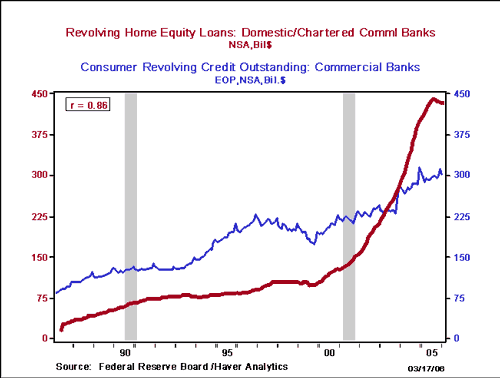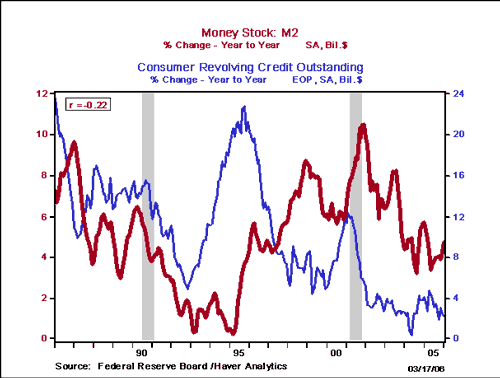That’s a frequent question—the answer lies within the important distinction between assets and liabilities. Money is a financial asset that one may spend—it represents an existing asset that may be used to purchase goods or services. When calculating the money supply, the Federal Reserve includes financial assets like currency and deposits. In contrast, credit card debts are liabilities. Each credit card transaction creates a new loan from the credit card issuer. Eventually the loan needs to be repaid with a financial asset—money. To households, the line of credit associated with a credit card is not a financial asset, only a convenient vehicle for borrowing to finance a purchase.
Money is an asset
Money is a financial asset, something that serves as a medium of exchange, acts as a standard of value that is generally acceptable for the purchases of goods and services or the repayment of debts, and serves as a unit of account. The Federal Reserve Board’s primary measures of the money supply consist mainly of currency plus financial assets on deposit with financial intermediaries and as assets held by households in money market mutual fund accounts.
The Federal Reserve’s two most popular monetary aggregates are M1 (the most liquid financial assets) and M2 (M1 plus other liquid financial assets.) A third measure of the money supply, M3, will be discontinued in 2006. M1 includes financial assets held by the non-bank public that may be used for transactions (mainly currency, demand deposits, and NOW accounts). As of October 2005, M1 was $1,362 billion on a seasonally adjusted basis. M2, which includes M1 plus consumer time and savings deposits, and retail money market mutual fund shares, was $6,629.5 billion. For a more complete definition of the components of the money supply and current money supply data, please see the Board’s weekly H.6 Release, Money Stock Measures and check out Ask Dr. Econ for April 2004.
A credit card transaction creates a liability
The use of credit, such as a credit card, is effectively the same as taking out a loan—that loan is a liability for the borrower. Samuelson and Nordhaus (2001) describe credit as, “…the use of someone else’s funds in exchange for a promise to repay (usually with interest) at a later date.”
Credit cards do provide a method of purchasing goods and services that is an alternative to using money. However, rather than purchasing goods with an existing financial asset—like the types of financial assets defined as money and included in the money supply statistics—credit card transactions create loans that the purchaser-borrower must later repay.
The category of consumer loans that includes credit card lending is called “revolving credit”; this measure was $801.4 billion on a seasonally adjusted basis as of October 2005. Additional detail on outstanding consumer credit is available from the Board’s monthly G.19 Release, Consumer Credit.
In recent years, as is shown in Chart 1, revolving credit outstanding at commercial banks has been surpassed as consumer borrowing has shifted towards loans backed by home equity lines of credit. In addition to rapid appreciation in home prices, creating home equity, home equity loans secured by housing equity have generally been priced well below rates on unsecured credit card debt.
Chart 1 — Bank Home Equity Loans Now Exceed Credit Card Debt

What about debit cards?
In contrast to purchases with credit cards, debit card purchases transfer money electronically from individual and business bank accounts to the sellers’ accounts. Spending with a debit card would affect demand deposits and the money supply in the same way that purchases with a check or cash does. Because a debit card transfers your existing financial assets—the financial assets that you may access with a debit card are included in the money supply.
Importance?
Why is it important to distinguish between financial assets (like money) and liabilities (like credit card debt)? First, from an economic standpoint, the Fed measures the amount of money in the hands of the public because of its potential use as an indicator of monetary policy; the money supply measures reflect the different degrees of liquidity that different types of money have. See Ask Dr. Econ (January 2003) for some historical perspective on the use of the monetary aggregates.
The Fed monitors the amount of money in the economy and tracks the amount of existing consumer credit. While both the money supply and existing credit card debt may be important indicators of trends in the economy, financial assets (money) and liabilities (credit card debt) may not behave similarly over time. Chart 2 compares the relationship between the growth rates for the M2 monetary aggregate and for credit card loans (revolving credit) over the period from 1985 to 2005. Over the period, money and consumer credit growth rates often moved in opposite directions (one should be careful to remember that correlation (even when negative) does not necessarily imply causation!). The point is that different economic factors will affect growth rates of the money supply and of credit card debt.
Chart 2 – Growth Rates of Monetary Aggregate M2 and Credit Card Debt

From a personal finance perspective
Finally, the difference between money and credit also is important from a personal finance perspective. You shouldn’t view a $1,000 credit card limit the same way you would view $1,000 in cash. Spending today using a credit card loan means that at some point in the future you will have to reduce your spending in order to pay back that credit card balance and any accumulated interest!
References (as of April 2006)
Consumer Credit (G.19 Release) 2005. Board of Governors of the Federal Reserve System.
“The Federal Reserve System: Purposes and Functions.” 2005. Board of Governors of the Federal Reserve System.
Mishkin, Frederic S. and Stanley G. Eakins. 2000. “Financial Markets and Institutions.” Reading, Massachusetts: Addison-Wesley.
Money Stock Measures (H.6 Release) 2005. Board of Governors of the Federal Reserve System.
Rose, Peter S. 1994. “Money and Capital Markets.” Burr Ridge, Illinois: Irwin.
Samuelson, Paul A. and William D. Nordhaus. 2001. “Economics.” 17th Edition. Boston: McGraw-Hill Irwin.